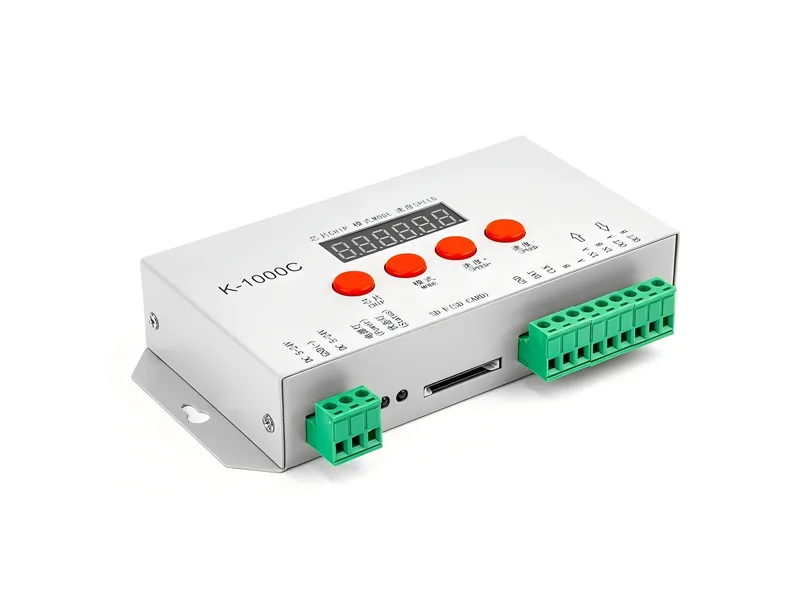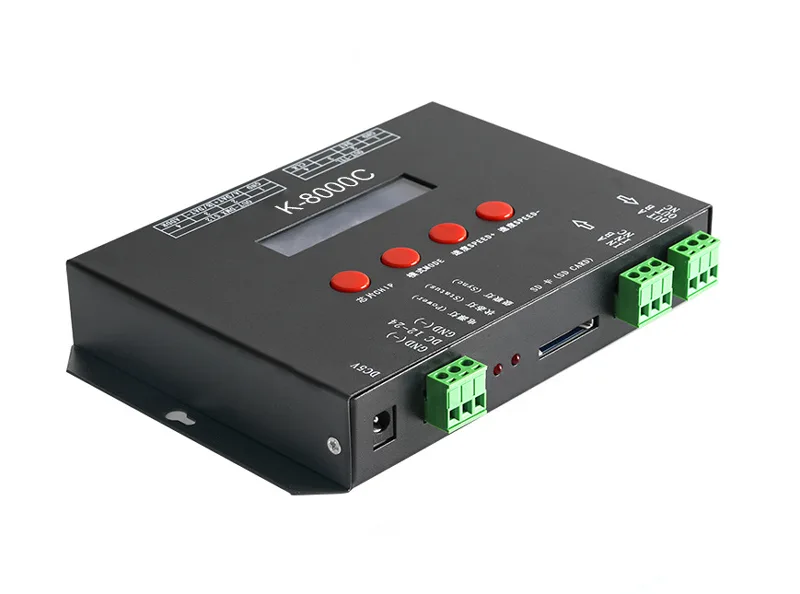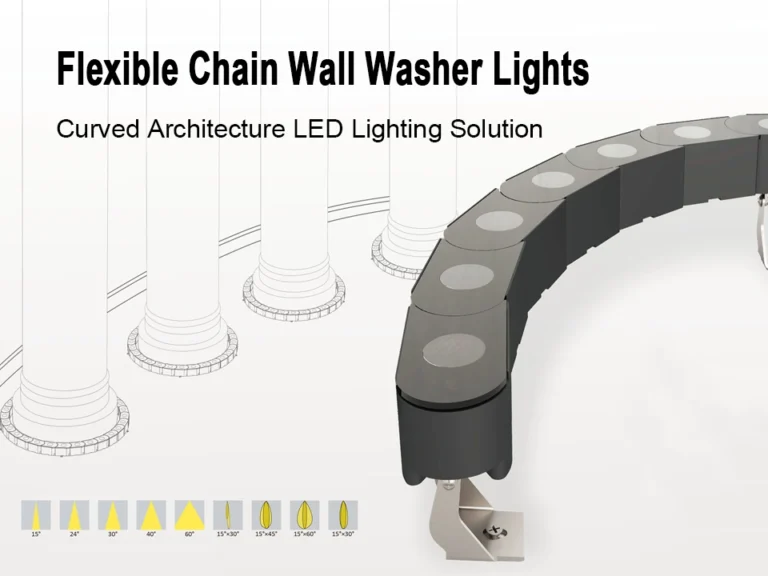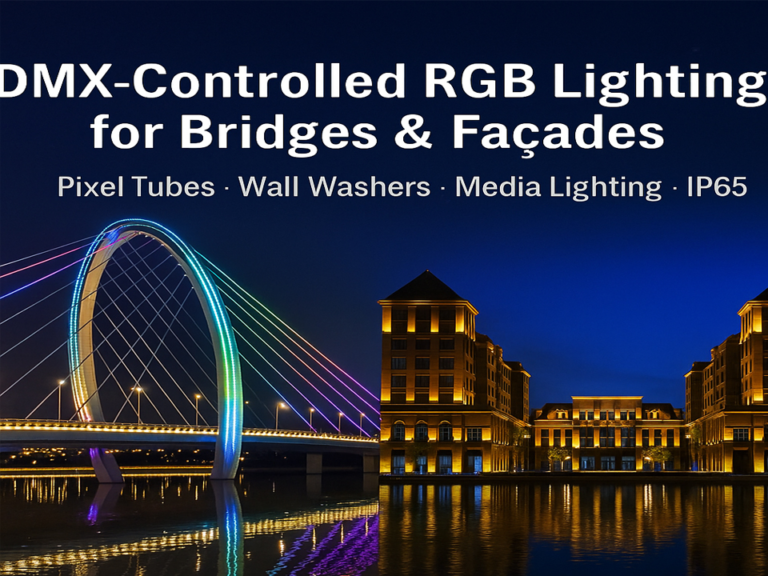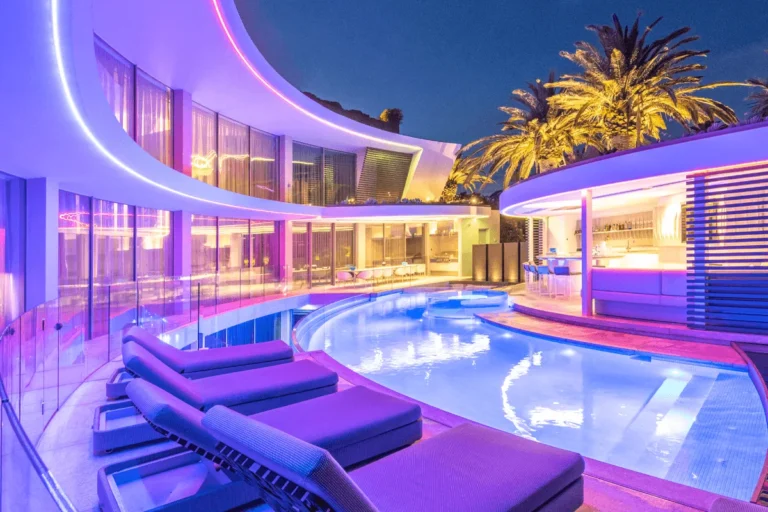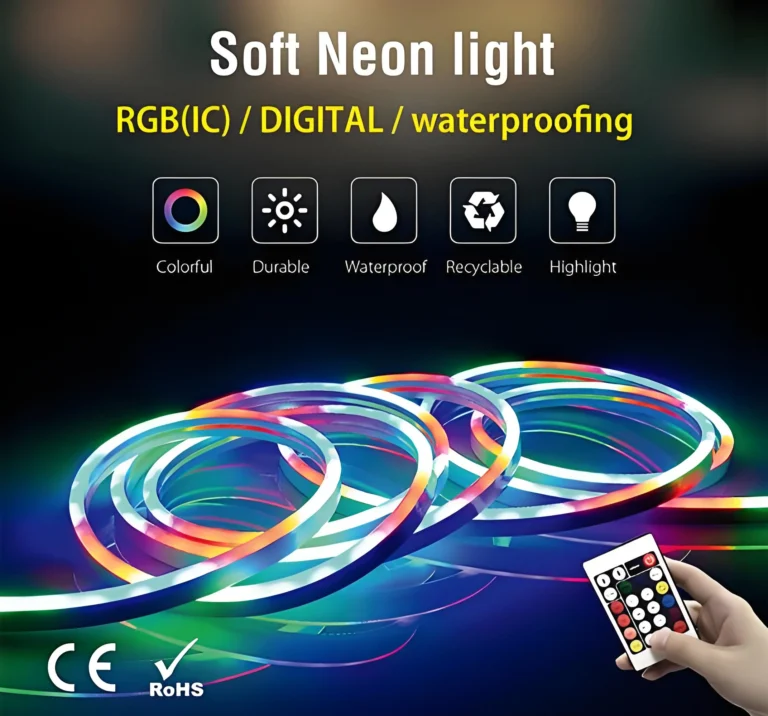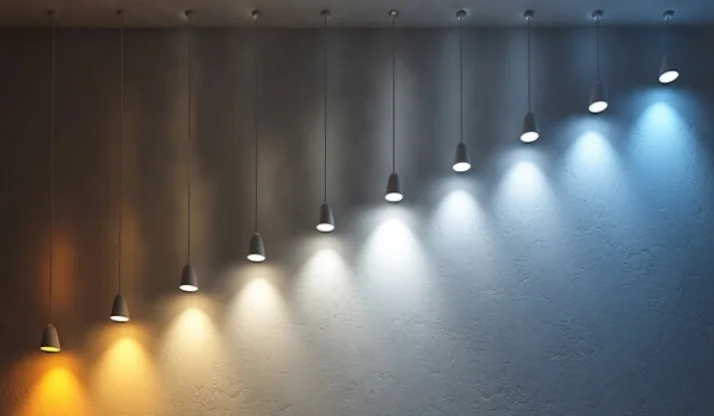Eine neue Generation der LED-Architekturbeleuchtung ist im Kommen: LED-Neon-Flex passt sich perfekt an geformte Gebäudehüllen an, verbraucht 85% weniger Energie als herkömmliches Neon, und mit dem intelligenten DMX512-Steuerungssystem können 2,56 Millionen Farbkombinationen in einem einzigen Gebäude realisiert werden.
Der spiralförmige Lichteffekt des Shanghai Center Tower und die pixelige Lichtshow des Guangzhou Tower bestätigen die unendlichen Möglichkeiten der digitalen Beleuchtung. Noch bemerkenswerter ist die Integration von IOT-Technologie - das Beleuchtungssystem des Ping An Building in Shenzhen kann auf PM2,5-Daten in Echtzeit reagieren und die städtische Luftqualität mit Licht und Schatten visualisieren. Intelligente Beleuchtung verwandelt die Gebäudefassade in eine digitale Leinwand, die so programmiert werden kann, dass sie nahtlos zwischen Szenen wie Feiertagsfeiern und Werbekampagnen wechselt. Die Beleuchtung des Vertical Forest in Mailand ahmt sogar den Photosyntheserhythmus der Bäume nach und macht das Gebäude zu einem lebenden Organismus.
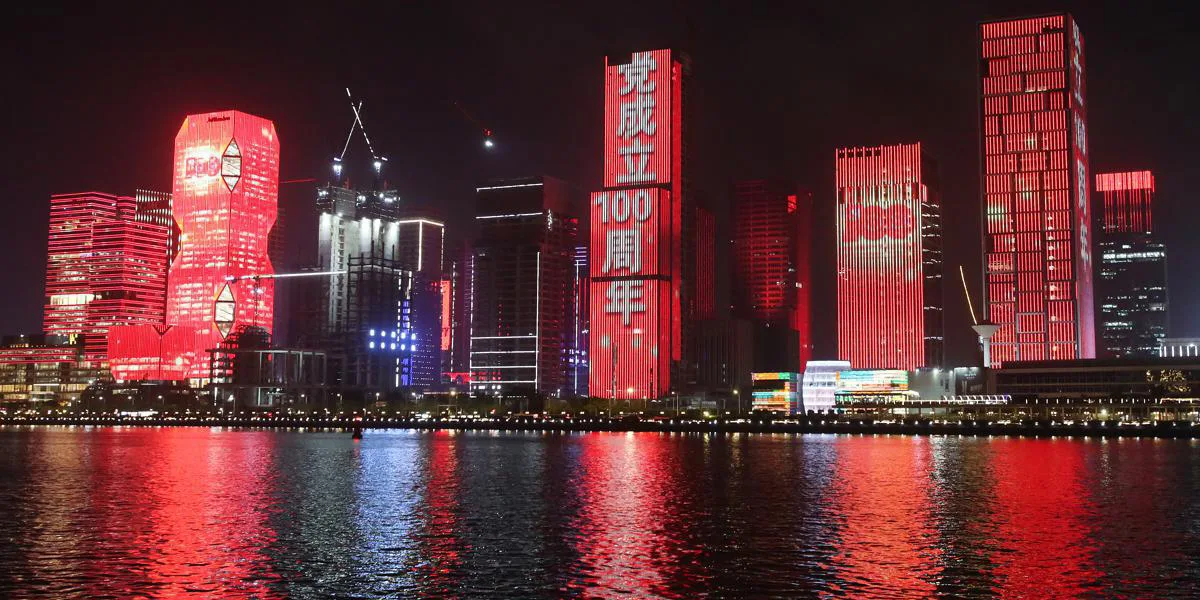
Im architektonischen Beleuchtungsdesign prägt die DMX-gesteuerte LED-Neon Flex mit ihrer überragenden Flexibilität und dynamischen Ausdruckskraft die räumliche Ästhetik neu. Über das DMX512-Protokoll können Designer die Helligkeit, Farbe und Dynamik jedes einzelnen Streifens präzise regulieren, was eine unendliche Kreativität vom allmählichen Atmen bis zu komplexen Rhythmen ermöglicht. In diesem technischen Leitfaden werden die Architektur von DMX-Beleuchtungssystemen, Designpunkte und die Produktauswahl konventioneller Geräte analysiert. Ich hoffe, Sie lesen es, um Ihnen zu helfen und Ihr Projekt schneller umzusetzen.
Vorteile des DMX512-Protokolls in der intelligenten Beleuchtung
Das DMX512-Protokoll ermöglicht die Steuerung von Licht zu Licht über 512 unabhängige Kanäle, die multidimensionale Parameter wie Farbe, Helligkeit, dynamische Effekte usw. präzise steuern können, um die strengen Anforderungen komplexer Lichteffekte in Szenen wie Bühnen und Gebäudefassaden zu erfüllen.
Seine Reaktionsgeschwindigkeit von einer Millisekunde gewährleistet den synchronisierten Betrieb großer Lampen und Laternen, was sich besonders für interaktive Echtzeitanwendungen wie dynamische Lichtverfolgung und Musikverknüpfung eignet. Dank der Master-Slave-Architektur und der differenziellen Signalisierung unterstützt es bis zu 32 Geräte in Reihe und Tausende von Knoten und bietet eine hervorragende Skalierbarkeit des Systems.
Standardisierte Schnittstellen und hohe Kompatibilität ermöglichen den nahtlosen Zugang zu Dimmern, Steuerungen und verschiedenen Arten von intelligenten Lampen. Die RS485-Basisschicht ist zudem störanfällig, um eine stabile Übertragung in der komplexen elektromagnetischen Umgebung des Projekts zu gewährleisten.
Diese technischen Eigenschaften machen DMX zur bevorzugten Steuerungslösung im Bereich großer Aufführungen, Themenlandschaften, Gebäudefassaden und anderer professioneller Beleuchtung.
Warum LED-Neon-Flex für die Architekturbeleuchtung verwenden?

Die Verwendung von Flexible LED-Neonstreifen für die Architekturbeleuchtung hat mehrere Vorteile. Zunächst einmal kann seine hohe Flexibilität komplexe gekrümmte Oberflächen oder geformte Strukturen anpassen, die Gebäudekonturen, Fassadendekorationen, Kuppelumrandungen und andere kreative Designs leicht realisieren und der Beleuchtungskunst eine stärkere Ausdruckskraft verleihen.
Das Neon-Lichtband ist modular aufgebaut und kann frei geschnitten und gespleißt werden, so dass es sich an verschiedene Größen von Installationsszenarien anpassen lässt, was die Schwierigkeiten bei der Konstruktion erheblich verringert.
Zweitens hat die LED-Lichtquelle eine hohe Lichtausbeute und niedrigen Energieverbrauch Eigenschaften, mit einem intelligenten Dimm-System, Energieeffizienz im Vergleich zu herkömmlichen Beleuchtung zu verbessern mehr als 50%, und geringe Wärmeerzeugung, wodurch die Wärmebelastung des Gebäudes.
Drittens unterstützt es die RGB-Farblichtmischung und die dynamische Programmierung und ermöglicht Farbverläufe, Lauflicht, Musikkopplung und andere Effekte über DMX oder drahtlose Protokolle, was die Interaktivität und den technologischen Sinn der architektonischen Nachtszene erhöht.
Darüber hinaus ist die äußere Schicht des flexiblen Streifens mit Silikon oder Epoxidharz ummantelt und bietet eine Wasserdichtigkeit bis zu IP67 oder höher, eine hohe Witterungsbeständigkeit, Anpassungsfähigkeit an Temperaturunterschiede im Freien, Regen und ultraviolette Umgebungen sowie eine Lebensdauer von bis zu 50.000 Stunden, was die Wartungskosten erheblich reduziert. Die Eigenschaften der Niederspannungsversorgung (12/24 V) erhöhen zudem die elektrische Sicherheit und machen sie zur bevorzugten Lösung für moderne Architekturbeleuchtungsprojekte.
Was ist das DMX512-System?
DMX512 (Digital Multiplex 512) ist ein digitales Steuerungsprotokoll, das im Bereich der Bühnenbeleuchtung, Architekturbeleuchtung usw. weit verbreitet ist. Es ermöglicht die präzise Steuerung von Scheinwerfern durch digitalisierte Signale. Das Grundprinzip ist die Übertragung von Steuerbefehlen durch serielle Kommunikation, und jede DMX-Signalverbindung besteht aus einem Master-Controller (z. B. einer Dimmerkonsole) und mehreren Slave-Geräten (Scheinwerfer, Dimmer usw.). Das System basiert auf dem RS-485-Standard für die physikalische Schicht und verwendet eine Technologie zur Übertragung von Differenzsignalen, die eine hohe Störsicherheit und eine maximale Übertragungsdistanz von bis zu 1200 Metern bietet (Repeater-Erweiterung erforderlich).
Jeder DMX-Datenrahmen enthält 512 unabhängige Steuerkanäle; jeder Kanal entspricht 8-Bit-Daten (Wertebereich 0-255), mit denen die Helligkeit, Farbe, Bewegungsspur und andere Parameter der Lampen eingestellt werden können. Eine RGB-LED-Leuchte beispielsweise belegt in der Regel 3 Kanäle (je 1 Kanal für Rot, Grün und Blau) und kann die entsprechenden Befehle empfangen, nachdem die Startkanalnummer über den Adress-Encoder eingestellt wurde. Die Steuerung sendet zyklisch Datenpakete mit einer maximalen Rate von 250 kbps, die etwa 44 Mal pro Sekunde aktualisiert werden, um die Echtzeitsynchronisation von Beleuchtungsänderungen zu gewährleisten. Das System unterstützt eine verkettete serielle Struktur; eine einzige Leitung kann bis zu 32 Geräte steuern und durch den Splitter auf Tausende von Knoten erweitert werden, um die Anforderungen großer Beleuchtungsprojekte zu erfüllen.
Das DMX512-System besteht hauptsächlich aus den folgenden Teilen:
DMX-KonsoleDas Hauptgerät, das Steuersignale sendet (z. B. eine Lichtkonsole oder Software).
DMX-EmpfängerDas Dekodiermodul im Gerät oder einer anderen Einrichtung, das Befehle empfängt und ausführt.
DMX-Kabel: Spezielles abgeschirmtes Twisted-Pair-Kabel, mit 5-poligem oder 3-poligem XLR-Stecker.
Abschlußwiderstand: Ein Widerstand (normalerweise 120 Ω) wird am Ende der Signalkette installiert, um Störungen durch Signalreflexionen zu verhindern.
Was sind die Merkmale der DMX512 Neon Tape?
- Der DMX Pixel Neon Strip besteht aus mehreren unabhängig voneinander gesteuerten LED-Perlen (Pixel). Jedes Pixel kann individuell in Farbe (z.B. RGB/RGBW) und Helligkeit eingestellt werden, um dynamische Muster oder Gradienteneffekte zu erzeugen. Jede LED kann unabhängig programmiert werden, um feine Animationseffekte zu erzielen (z. B. fließendes Wasser, Blinken, Verblassen).
- Im Vergleich zu herkömmlichen Neonröhren ist sie energieeffizienter, langlebiger und unterstützt die Programmiersteuerung.
- Der mit flexiblen Materialien (z. B. Silikon, PVC) umwickelte LED-Leuchtstreifen kann frei gebogen und geschnitten werden, um sich an die Installationsumgebung komplexer Formen (z. B. gekrümmte Oberflächen, gekrümmte Strukturen) anzupassen.
- Übertragung über große Entfernungen (bis zu 1200 Meter), hohe Kompatibilität, und kann mehrere Geräte gleichzeitig steuern.
- Unterstützt eine hochauflösende Anzeige, geeignet für Text, Muster und bewegte Bilder.
- Senden Sie Befehle über den DMX-Controller, der mit anderen Bühnenbeleuchtungsgeräten wie Moving Head Lights, Laserlicht usw. synchronisiert werden kann, um einen einheitlichen Effekt zu erzielen.
- Unterstützt Multi-Universum-Erweiterung, um den Anforderungen einer groß angelegten Installation gerecht zu werden (z. B. Gebäudefassade, große Bühne).
- Hohe Wasserdichtigkeit, furchtlos in rauen Außenumgebungen, normalerweise bis zu IP65 oder IP67, geeignet für den Innen- und Außeneinsatz.
- Zuschneidbares Design: Die Länge kann je nach Bedarf angepasst werden, was den Installationsaufwand reduziert.
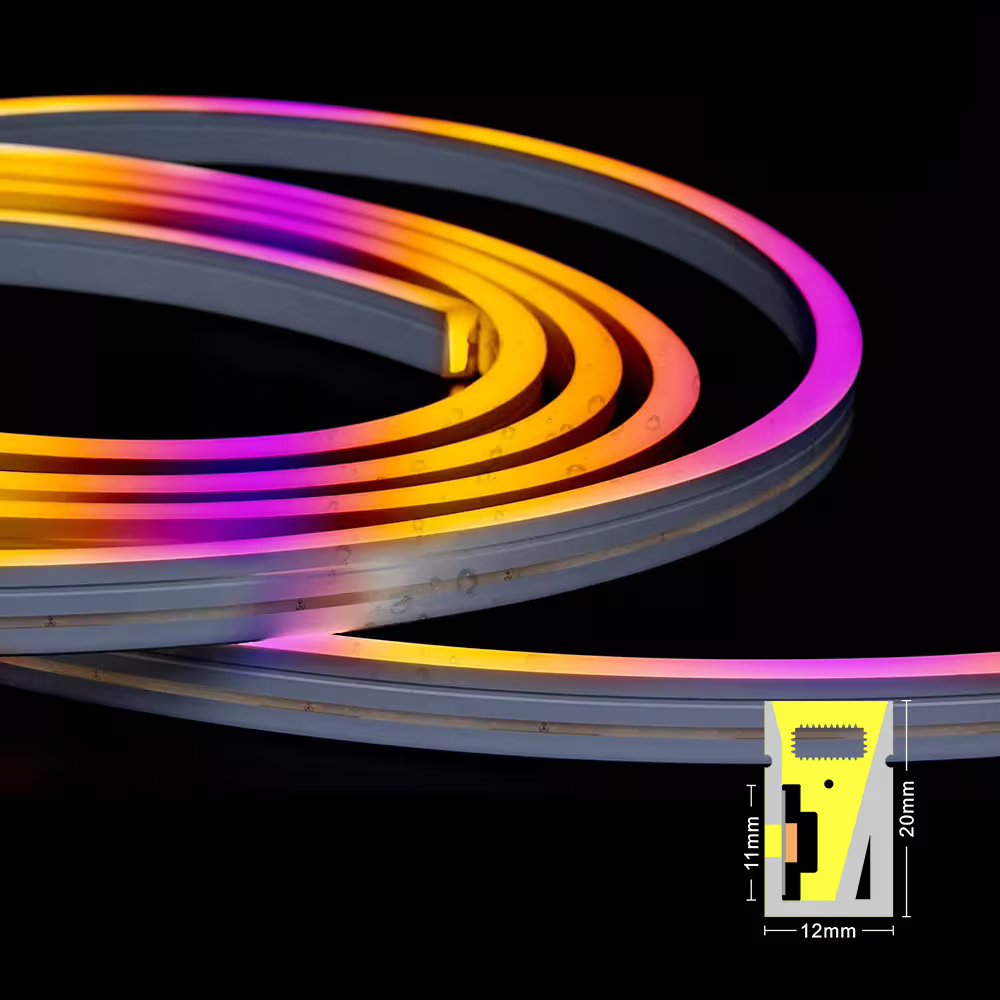
Side Bend S1220 Silikon-Adressierbarer LED-Leuchtstreifen für Architektur-, Wandverglasungs- und Fassadenbeleuchtung
Eingangsspannung: DC24V
Watt: 12W/m@RGB, 19W/m@RGBW
LED-Anzahl: SMD5050 60LEDs/m
Farbtemperatur: RGB/RGBW(2700K-6500K)
Signal-Typ: SPI/DMX512
Schutzart: IP65/IP67
Kabeleingang: Vorderseite
Min. Biegedurchmesser: 100 mm
Zuschneidbare Länge: 100mm
Länge: 5Meter/Rolle
Wie steuert DMX512 einen LED-Leuchtstreifen?
Der DMX512-Controller sendet Befehle an das LED-Neon-Streifen-System durch digitale Signale (nach dem RS-485-Standard); das Signal wird vom Decoder analysiert und passt dann die RGB-Kanaldaten jedes LED-Pixels entsprechend der voreingestellten Adresse an, um die Helligkeit (0-255 Level) und Farbe unabhängig einzustellen. Durch die Programmierung von voreingestellten Szenen oder Echtzeit-Steuerung, um dynamische Farbverläufe, synchronisiertes Blinken und andere Effekte für die Bühne, Gebäude und andere Szenen zu erreichen, um sicherzustellen, dass mehrere Geräte zusammenarbeiten und Anti-Interferenz, die spezifische Steuerung Verbindungen beziehen sich auf den folgenden Schaltplan.
Schaltplan für den Anschluss des DMX512-Systems:
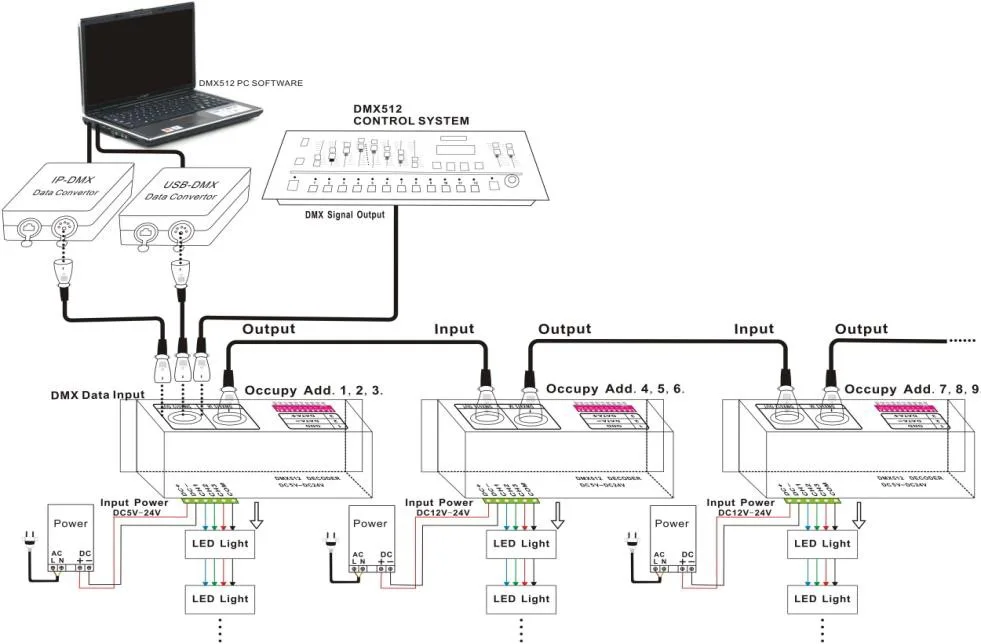
DMX512 Steuergeräteauswahl
I. DMX512-Master
DMX512-Master geben ein Signal des internationalen Standards DMX512/1990 an DMX512-Decoder aus, um einfarbige, zweifarbige CCT-, RGB-, RGBW- und RGB+CCT-LED-Beleuchtung zu steuern. Die beiden am häufigsten verwendeten Decoder sind die folgenden:
1. DMX512 Touch Panel Steuerung: Unterstützt DMX512-Ausgang, mit integrierter Dimmung, Farbtemperaturanpassung, RGB/RGBW-Steuerungsfunktionen und der Möglichkeit, Zonen zu verwalten (bis zu 4 Zonen), und integriert mehrere dynamische Modi (wie Gradient und Jump). Das 86-fache Installationsdesign eignet sich für kommerzielle oder private Szenarien.
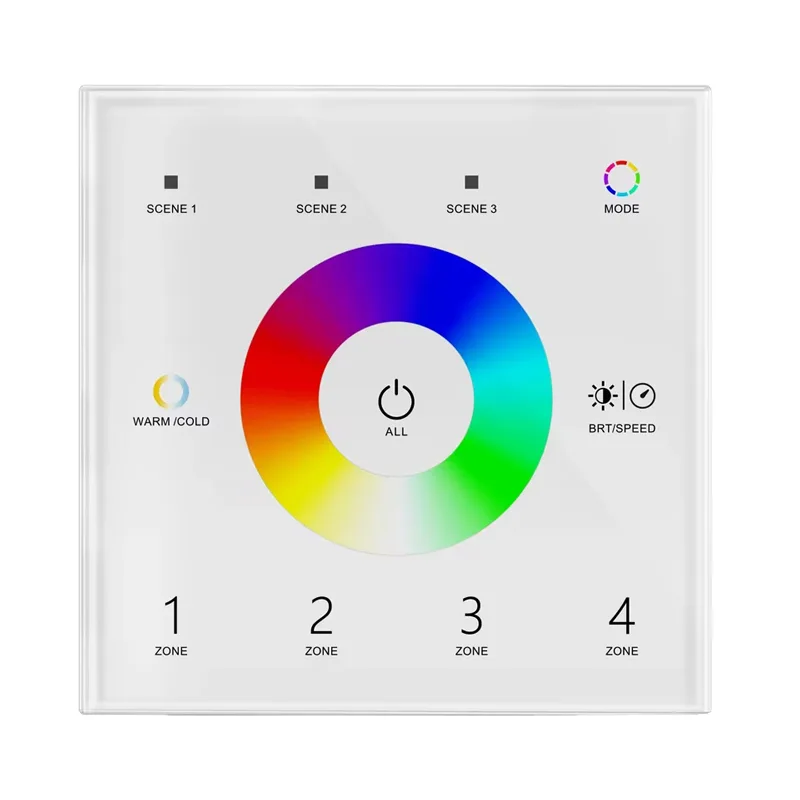
T15 Wandmontiertes DMX512 Touch Panel
● Der 4-Zonen-1-5-Farben-DMX512-Master mit Touchpanel kann auch als 4-Zonen-1-5-Farben-RF-Fernbedienung verwendet werden.
● DMX-Signalausgang, konform mit dem Standardprotokoll DMX512, kompatibel mit DMX-Decodern beliebiger Hersteller.
Bei Verwendung als RF-Fernbedienung kann jede Zone mehrere RF 2.4G LED-Controller, Dimm-Treiber oder intelligente Lampen fernsteuern.
● Ultra-empfindlich, hochfest.
Download T15 Wall Mounted DMX512 Touch Panel Datenblatt
Preis: 24,98 USD/Stück
2. DMX512-Steuerungr: Der DMX512-Controller ist ein zentrales Gerät, das für die zentrale Steuerung und Kontrolle der Bühnenbeleuchtung und der Spezialeffektgeräte für die Architekturbeleuchtung verwendet wird. Er überträgt Anweisungen durch digitale Signale auf der Grundlage des DMX512-Protokolls. Er kann mehrere Geräte (z. B. Lampen und Motoren) gleichzeitig steuern, Parameter wie Helligkeit, Farbe und dynamische Effekte präzise einstellen und die entsprechenden Kanaldaten für jedes Gerät über eine unabhängige Adresse identifizieren. Sie unterstützt die Programmierung voreingestellter Szenen oder die Echtzeitsteuerung, um die Synchronisierung und Automatisierung von Lichtänderungen zu erreichen.
Die K-1000C und K-8000C sind für die Offline-Steuerung geeignet. Sie können in einer einzigen Einheit oder in mehreren Kaskaden verwendet werden, um mehr LED-Pixel anzusteuern.
a. Wenn die Hauptlampe weniger als 80.000 Pixel hat, wird empfohlen, den DMX-Pixel-Controller K-1000C zu verwenden.
b. Wenn die Hauptlampe 8.000 bis 20.000 Pixel hat, wird empfohlen, den K-8000C DMX LED Pixel Controller zu verwenden.

II. DMX-SPI-Decoder
Wandeln Sie das DMX512-Signal in ein Protokoll um, das von LED-Lichtleisten erkannt werden kann (z. B. SPI). Zum Beispiel werden Chips wie TM1803 und UCS512 verwendet, wobei jeder Chip der RGB-Kanalsteuerung eines oder mehrerer LED-Pixel entspricht.
Jedem LED-Pixel muss ein unabhängiger Adresscode zugewiesen werden, und die Punkt-für-Punkt-Steuerung wird durch Kanalzuordnung erreicht (zum Beispiel belegen RGB-Pixel drei DMX-Kanäle).
Er kann über die DMX-Konsole gesteuert werden, und Sie können mehrere DMX-Decoder anschließen, um die Ausgangsleistung zu erhöhen und alle Funktionen zu erreichen. Verschiedene Modi der Veränderung. Darüber hinaus kann der DMX-Decoder auch als Synchronisator verwendet werden. Der Controller steuert die LED separat, um einen Synchronisationseffekt zu erzielen.
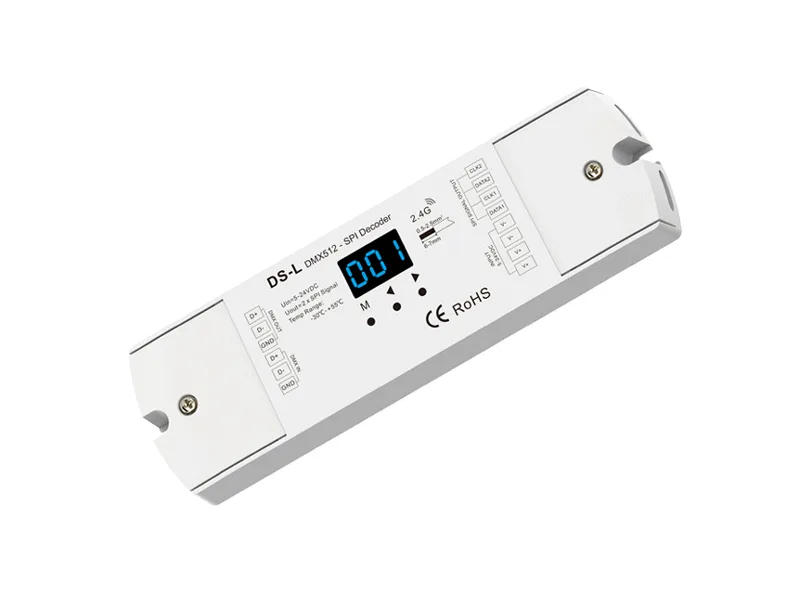
DMX zu SPI RGB RGBW Decoder und RF Controller
Modell: CTL-RGB-DMX-DS-L
Versorgungsspannung: DC5V~24V
Leistungsaufnahme: 1W
Eingangssignal: DMX512 + RF 2.4GHz
Ausgangssignal: SPI(TTL) x 3/4 Kanäle
Dynamischer Modus: 32
Kontrollpunkte: 170 Pixel (RGB 510 CH), maximal 900 Pixel
Abmessungen: L175 x B54 x H27mm
Datenblatt für CTL-RGB-DMX-DS-L herunterladen
Preis: 16,98 USD/Stück
III. DMX-Signalverstärker DA für wasserdichte LED-Leuchtstreifen
Es dient zur Verlängerung der Übertragungsstrecke von DMX-Signalen und unterstützt 1 Eingang und mehrere Ausgänge. Er verbessert die Signalstabilität durch photoelektrische Isolationstechnologie und ist für große Entfernungen oder komplexe elektromagnetische Umgebungen geeignet.
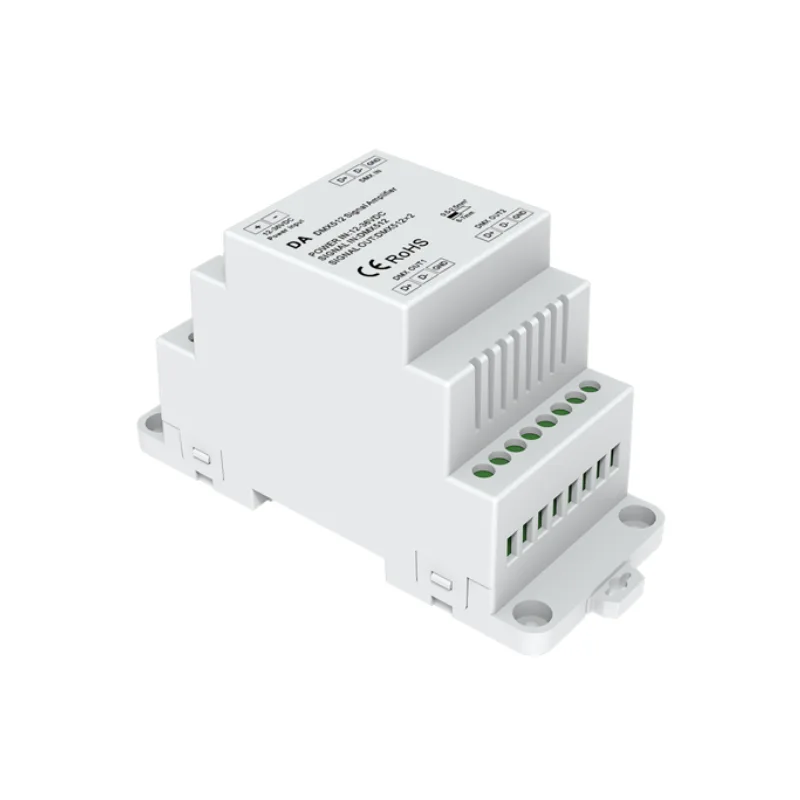
DA DMX-Signal-Verstärker
● 2-Kanal DMX 512 Signalverstärker.
● Ein DMX512-Signaleingang, zwei DMX512-Signalausgänge. Speziell für die Verstärkung, Verteilung und Isolierung des Signals, das von der DMX-Lichtanlage kommt, wenn sie an den DMX512-Bus (oder RS-485) angeschlossen ist.
● Erweitern Sie die Signalübertragungsdistanz.
● Signalerweiterung der Ausgangssteuerung; Erhöhung des DMX (485) Signalverstärkers zur Verteilung der Mehrkanalsteuerung.
Preis: 24,98 USD/Stück
Wie konfiguriere ich die Stromversorgung?
Ein DMX512-LED-Leuchtbandsystem besteht in der Regel aus mehreren Lichtsegmenten, die je nach Gesamtlast und dynamischen Veränderungen eine gewisse Reserve benötigen.
1. Berechnung der Gesamtlastleistung: P gesamt = ∑ (Leistung des einzelnen Lichtabschnitts × Anzahl)
Leistung einzelner Lichtabschnitte: DMX512-LED-Neonstreifenleistung pro Meter oder pro Abschnitt (z. B. 5 W/m).
Beispiel: Es gibt 10 Abschnitte eines Lichtbandes, jeder Abschnitt ist 3 Meter lang, die Leistung pro Meter beträgt 8 W. Gesamt = 10 × 3 × 8 = 240 W
2. Berechnung der Nennleistung des NetzteilsLeistung = P gesamt × (1 + Sicherheitsfaktor) ÷ Leistungseffizienz + P (DMX-Steuerung)
Sicherheitsfaktor: Es wird empfohlen, 0,2~0,3 zu nehmen (das DMX-System kann häufige Dimm- und Stromschwankungen aufweisen).
Leistungseffizienz: normalerweise 85%~95% (Schaltnetzteil ist effizienter).
Leistungsaufnahme des DMX-Controllers: in der Regel 5~20 W (bitte beachten Sie das jeweilige Modell).
Beispiel:
Gesamtlast 240 W, Sicherheitsfaktor 0,3, Wirkungsgrad des Netzteils 90%, Leistungsaufnahme des Reglers 15 W:
Stromversorgung = 240X1.3÷0.9+15≈303+15=362W
Es sollte ein Netzteil ≥ 360W gewählt werden.
Markennetzteile (z. B. Mean Well XLG-Serie) werden empfohlen, um Signalstörungen und Spannungsabfallprobleme zu minimieren. Sorgen Sie für eine stabile Spannung (normalerweise DC12V oder 24V), die der Leistung des Lichtbalkens entspricht (z.B. 12W/m@RGB).
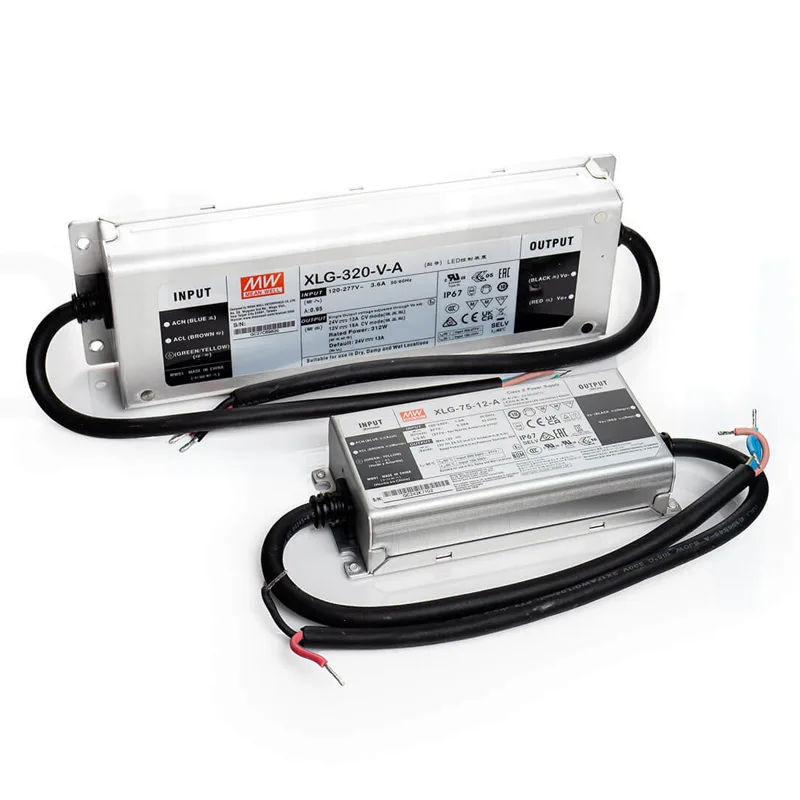
Mean Well XLG Serie IP67 Konstantspannungs-LED-Netzteil
Was ist ein Spannungsabfall?
Einfach ausgedrückt, Spannungsabfall ist der Energieverlust, der während des Spannungsflusses in einem Stromkreis auftritt, wenn Strom durch eine LED-Leuchte fließt. Dieser Prozess ist vergleichbar mit dem Fluss von Wasser durch ein enges Rohr; die Geschwindigkeit des Wassers wird durch Reibung zu einem gewissen Energieverlust führen. Bei LED-Lampen und -Laternen führt der Spannungsabfall zu einer unzureichenden Leistungsabgabe, was die Lichtausbeute und die Lebensdauer der Lampen und Laternen beeinträchtigt.
Das Problem des Spannungsabfalls bei LED-Leisten tritt auf, wenn die LED-Leiste an die Stromversorgung angeschlossen ist. Aufgrund der Länge des Stromkreises und des geringen Stroms, der durch den Spannungsverlust verursacht wird, ist die Helligkeit der LED-Leiste nicht ausreichend oder ungleichmäßig. Dieses Problem ist sehr schwierig für Benutzer, die LED-Lichtstreifen für eine lange Zeit verwendet haben, so müssen sie eine Lösung zu suchen!
Ursachen für Spannungsabfall bei LED-Leuchtbändern:
- Kleinerer StromDer Strom von LED-Leuchtbändern ist in der Regel gering und liegt zwischen 0,02 und 0,03 A. Daher treten Spannungsverluste schon bei kurzen Leitungen auf, bei langen Leitungen sind sie noch ausgeprägter.
- Länge der Linie: Im Allgemeinen gilt: Je länger die Leitung zwischen dem Treiber und dem LED-Leuchtband ist, desto größer ist das Problem des Spannungsabfalls.
- Fragen der Qualität: Die Qualität des LED-Bands kann sich ebenfalls auf den Spannungsabfall auswirken. Bei einigen minderwertigen LED-Streifen kann es zu Problemen mit dem Spannungsabfall kommen, weil der Innenwiderstand zu hoch oder zu niedrig ist, was den Leitungswiderstand erhöhen kann.
Wie wählt man Kabel für die Installation von LED-Leuchtstoffröhren aus?
DMX512 System Niederspannungsnetzteil (12V/24V DC), ist der Leitungsstrom groß, der Spannungsabfall Problem ist besonders prominent, und Sie müssen sicherstellen, dass die Endspannung stabil ist.
Um die Gleichmäßigkeit der Lichtstärke vor und nach den Lampenkugeln zu gewährleisten und die Auswirkungen des Spannungsabfalls auf das Lichtband zu vermeiden, können wir in der Regel die folgenden Methoden anwenden:
● Erhöhen Sie den Drahtdurchmesser: reduzieren Sie den Leitungswiderstand (üblicher Drahtdurchmesser: 1,5 mm², 2,5 mm²).
● Segmentierte Stromversorgung: Bei der Verkabelung über große Entfernungen sollte die Stromversorgung in mehrere Stromkreise aufgeteilt werden.
● Erhöhen Sie die Versorgungsspannung: Wenn der Spannungsabfall am Ende zu groß ist, verwenden Sie eine etwas höhere Versorgungsspannung (z. B. ein 24-Volt-System anstelle von 12 Volt).
Um richtig mit dem Spannungsabfall umzugehen, aber auch nicht auf den Leiter verlassen, um den Drahtdurchmesser zu erhöhen, die Notwendigkeit zu berücksichtigen, die erhöhten Kosten und die Rationalität der Verdrahtung zu nehmen. Wir können die folgenden Schritte richtig wählen, um das Problem des Spannungsabfalls weiter auszugleichen.
Schritt 1. Berechnen Sie den Abzweigstrom
Das DMX-System ist in der Regel in mehrere Steuerkreise unterteilt, die für jeden Lastkreis einzeln berechnet werden müssen:
I einfach = P einfach / V Arbeit
Beispiel: eine einzelne Last von 3 Abschnitten des Bandes (3m × 8 W/m × 3 Abschnitte = 72 W), die Betriebsspannung beträgt 24 V.
I einzelner Stromkreis = 72/24 = 3,0A
Schritt 2: Berechnen Sie den Spannungsabfall
R=ρ×(2L/A)
ΔU=I Einzelschaltung×R Leitung
Wichtige Parameter:
ρ: Widerstandswert des Kupferdrahtes von 0,0172 Ω-mm²/m.
L: Entfernung in einer Richtung von der Stromversorgung bis zum Ende (Einheit: Meter).
A: Querschnittsfläche des Drahtes (Einheit: mm²).
2L: Die Gesamtlänge des aktuellen Hin- und Rückweges beträgt 2L.
Beispiel:
Einkreisstrom 3A, Leitungslänge einseitig 15 Meter, Verwendung von 1,5mm² Kupferdraht:
R = 0,0172 x (2 x 15/1,5) = 0,344 Ω
Spannungsabfall: ΔU=3AX0.344Ω≈1.032VV
Endspannung: 24V-1,032V=22,97V (Spannungsabfall von 4,29%, entsprechend den Anforderungen von ≤5%).
Zulässiger Spannungsabfall: darf in der Regel 5%-10% der Betriebsspannung nicht überschreiten (Spannungsabfall im 12V-System ≤ 0,6-1,2V, im 24V-System ≤ 1,2-2,4V).
Vorsichtsmaßnahmen:
1. Trennung von Signal- und Stromversorgung: Es wird empfohlen, eine unabhängige Stromversorgung zu verwenden. Bei einem DMX-Controller und einer LED-Lichtleiste wird empfohlen, eine unabhängige Stromversorgung zu verwenden, um Interferenzen zu vermeiden.
2. Abgeschirmtes Kabel: Die DMX-Signalleitung muss ein verdrilltes, abgeschirmtes Kabel (z. B. CAT5e) verwenden und einen Abstand von mehr als 30 cm zur Stromleitung einhalten.
3. Segmentierte Stromversorgungsstrategie: Bei der Installation über große Entfernungen sollten Sie alle 20-30 Meter eine Steckdose einrichten, um den Spannungsabfall in einem einzelnen Stromkreis zu verringern.
4. Synchronisierung der Stromversorgung: Wenn mehrere Netzteile parallel geschaltet sind, sorgen Sie für eine gemeinsame Masse oder verwenden Sie ein Synchronisationsmodul, um zu vermeiden, dass Potenzialunterschiede die DMX-Signale stören.
5. Messung der Endspannung: Verwenden Sie ein Multimeter, um sicherzustellen, dass die Endspannung ≥90% der Nennspannung ist.
6. Test der Signalstabilität: Prüfen Sie, ob das DMX-Signal flackert oder Pakete aufgrund von Netzstörungen verloren gehen.
7. Test des Temperaturanstiegs: Nach 1 Stunde Volllastbetrieb sollte die Oberflächentemperatur des Netzteils ≤60℃ sein.
Für die Installation im Freien lesen Sie bitte den Beitrag: LED-Neon-Flex-Montagelösungen für den Außenbereich für Architekten und Installateure.
Zusammenfassung
DMX-gesteuert LED Neon Flex hat sich dank seines standardisierten Protokolls und seiner hohen Störsicherheit zu einer idealen Wahl für architektonische Beleuchtungsprojekte entwickelt.
Die Technologie ermöglicht eine präzise Beleuchtungssteuerung über das DMX512-Protokoll, unterstützt die Übertragung von Signalen über große Entfernungen (bis zu Hunderten von Metern) und die Synchronisierung mehrerer Knotenpunkte und kann Helligkeit, Farbe und dynamische Effekte flexibel einstellen, was sich für die Dekoration von Gebäudefassaden, Landschaftsbeleuchtung und andere Szenarien eignet.
Es verwendet eine differenzielle Signalübertragungstechnologie, um elektromagnetische Störungen zu vermeiden, und unterstützt die Breakpoint-Übertragungsfunktion, um die Systemstabilität zu verbessern. Praktische Anwendungen müssen auf die Adresseinstellungen und die Linienplanung achten, wie z. B. die Verwendung des DMX512-Adresseditors, um die Adresse der Lampen und Laternen zu konfigurieren und über den Controller (z. B. Interact IoT-Plattform) eine zentralisierte Verwaltung zu erreichen und den Energieverbrauch und die Wartungseffizienz zu optimieren.
Kombiniert mit intelligenter Dimm- und Zonensteuerung kann das DMX512-LED-Neonlichtsystem eine präzise Steuerung und gleichmäßige Helligkeit durch vernünftiges Design realisieren und gleichzeitig einen langfristigen zuverlässigen Betrieb gewährleisten.
